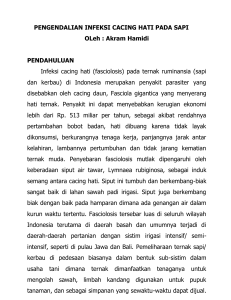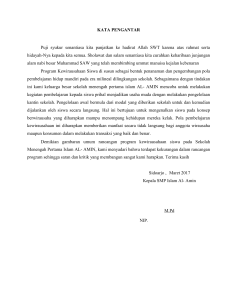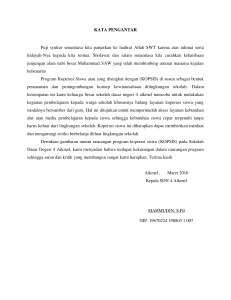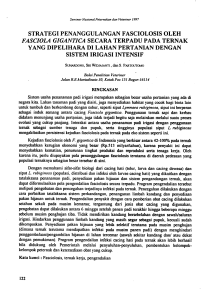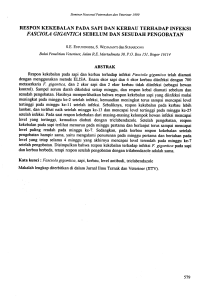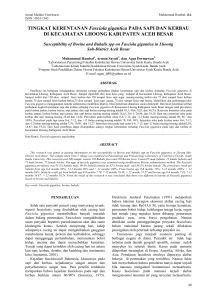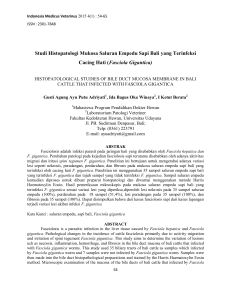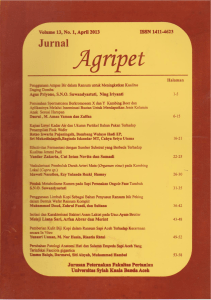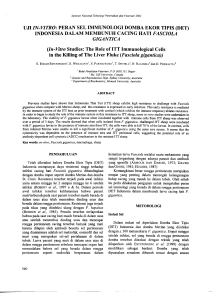xi FASCIOLOSIS : EPIDEMIOLOGI DAN KERUGIAN EKONOMI
advertisement
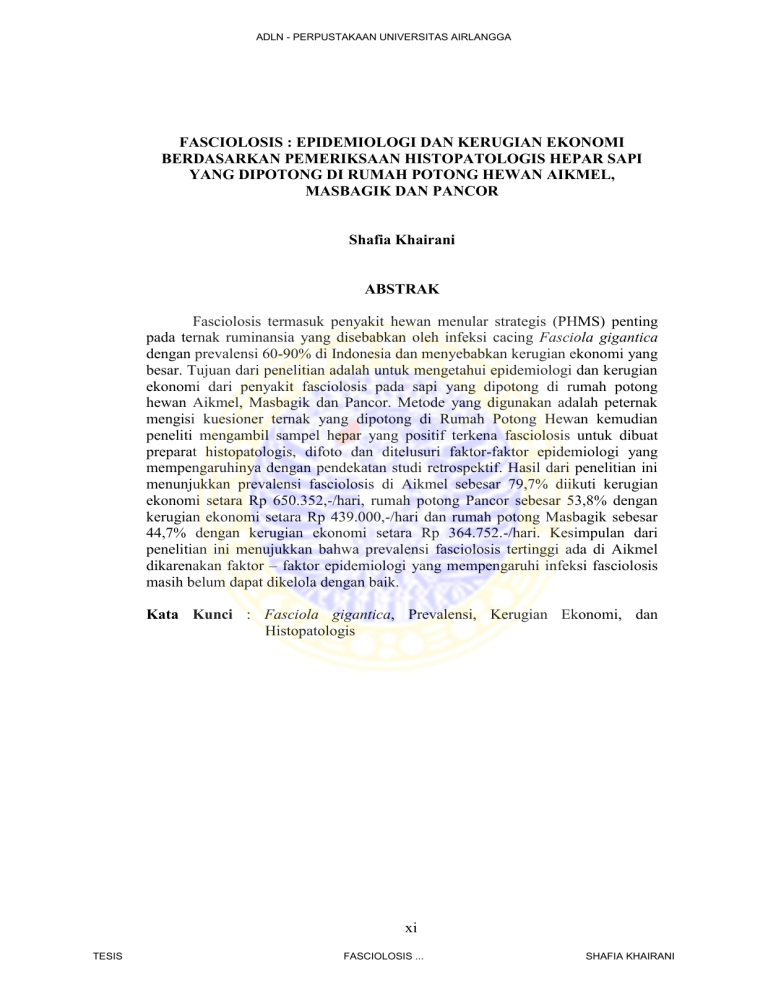
ADLN - PERPUSTAKAAN UNIVERSITAS AIRLANGGA FASCIOLOSIS : EPIDEMIOLOGI DAN KERUGIAN EKONOMI BERDASARKAN PEMERIKSAAN HISTOPATOLOGIS HEPAR SAPI YANG DIPOTONG DI RUMAH POTONG HEWAN AIKMEL, MASBAGIK DAN PANCOR Shafia Khairani ABSTRAK Fasciolosis termasuk penyakit hewan menular strategis (PHMS) penting pada ternak ruminansia yang disebabkan oleh infeksi cacing Fasciola gigantica dengan prevalensi 60-90% di Indonesia dan menyebabkan kerugian ekonomi yang besar. Tujuan dari penelitian adalah untuk mengetahui epidemiologi dan kerugian ekonomi dari penyakit fasciolosis pada sapi yang dipotong di rumah potong hewan Aikmel, Masbagik dan Pancor. Metode yang digunakan adalah peternak mengisi kuesioner ternak yang dipotong di Rumah Potong Hewan kemudian peneliti mengambil sampel hepar yang positif terkena fasciolosis untuk dibuat preparat histopatologis, difoto dan ditelusuri faktor-faktor epidemiologi yang mempengaruhinya dengan pendekatan studi retrospektif. Hasil dari penelitian ini menunjukkan prevalensi fasciolosis di Aikmel sebesar 79,7% diikuti kerugian ekonomi setara Rp 650.352,-/hari, rumah potong Pancor sebesar 53,8% dengan kerugian ekonomi setara Rp 439.000,-/hari dan rumah potong Masbagik sebesar 44,7% dengan kerugian ekonomi setara Rp 364.752.-/hari. Kesimpulan dari penelitian ini menujukkan bahwa prevalensi fasciolosis tertinggi ada di Aikmel dikarenakan faktor – faktor epidemiologi yang mempengaruhi infeksi fasciolosis masih belum dapat dikelola dengan baik. Kata Kunci : Fasciola gigantica, Prevalensi, Kerugian Ekonomi, dan Histopatologis xi TESIS FASCIOLOSIS ... SHAFIA KHAIRANI ADLN - PERPUSTAKAAN UNIVERSITAS AIRLANGGA FASCIOLOSIS: EPIDEMIOLOGY AND ECONOMICAL IMPACT BASED ON HISTOPATHOLOGICAL EXAMINATION OF LIVER COWS SLAUGHTERED IN AIKMEL, MASBAGIK AND PANCOR ABATTOIRS Shafia Khairani ABSTRACT Fasciolosis is an important disease in ruminants caused by heartworm infections Fasciola gigantica with prevalence of 60-90% in Indonesia and caused huge economical impact. The aim of the study was to determine the epidemiology and economical impact from fasciolosis disease in cattle slaughtered in abattoirs Aikmel, Masbagik and Pancor. The method of this study is to fill out questionnaires livestock breeders slaughtered in Slaughterhouse then researcher took samples that tested positive for fasciolosis and made histopathological preparation, photographed and traced the epidemiological factors that influenced by retrospective study. Results from this study showed that the prevalence of fasciolosis in Aikmel Abattoir was 79.7%, and economical impact Rp 650.352,/day, Pancor Abattoir was 53.8%, with economical impact Rp 439.000,-/day and Masbagik Abattoir was 44.7% with economical impact Rp 364.752,-/day. The conclusion from this study showed that the prevalence of fasciolosis is highest in Aikmel because the epidemiological factors that affect fasciolosis infection still cannot be managed properly. Key Words : Fasciola gigantica, Prevalence, Economical Impact, and Histopathological examination. xii TESIS FASCIOLOSIS ... SHAFIA KHAIRANI


